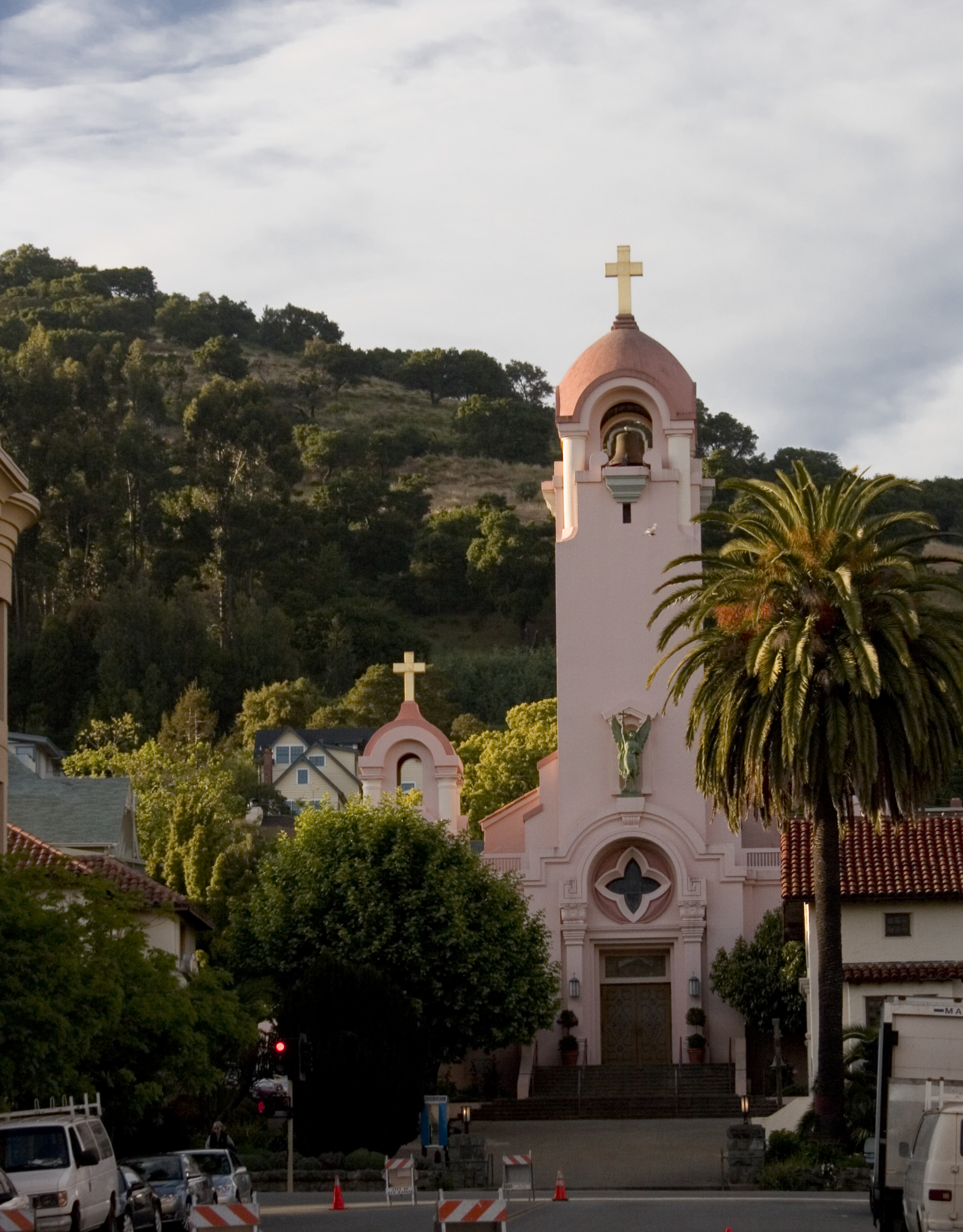|
Lawsonite
Lawsonite is a hydrous calcium aluminium sorosilicate mineral with formula CaAl2Si2O7(OH)2·H2O. Lawsonite crystallizes in the orthorhombic system in prismatic, often tabular crystals. Crystal twinning is common. It forms transparent to translucent colorless, white, and bluish to pinkish grey glassy to greasy crystals. Refractive indices are nα=1.665, nβ=1.672 - 1.676, and nγ=1.684 - 1.686. It is typically almost colorless in thin section, but some lawsonite is pleochroic from colorless to pale yellow to pale blue, depending on orientation. The mineral has a Mohs hardness of 8 and a specific gravity of 3.09. It has perfect cleavage in two directions and a brittle fracture. Lawsonite is a metamorphic mineral typical of the blueschist facies. It also occurs as a secondary mineral in altered gabbro and diorite. Associate minerals include epidote, titanite, glaucophane, garnet and quartz. It is an uncommon constituent of eclogite. Lawsonite was first described in 1895 for o ... [...More Info...] [...Related Items...] OR: [Wikipedia] [Google] [Baidu] |
Blueschist Facies
Blueschist (), also called glaucophane schist, is a metavolcanic rock that forms by the metamorphism of basalt and rocks with similar composition at high pressures and low temperatures (), approximately corresponding to a depth of . The blue color of the rock comes from the presence of the predominant minerals glaucophane and lawsonite. Blueschists are schists typically found within orogenic belts as terranes of lithology in faulted contact with greenschist or rarely eclogite facies rocks. Petrology Blueschist, as a rock type, is defined by the presence of the minerals glaucophane + ( lawsonite or epidote ) +/- jadeite +/- albite or chlorite +/- garnet +/- muscovite in a rock of roughly basaltic composition. Blueschist often has a lepidoblastic, nematoblastic or schistose rock microstructure defined primarily by chlorite, phengitic white mica, glaucophane, and other minerals with an elongate or platy shape. Grain size is rarely coarse, as mineral growth is retarded by t ... [...More Info...] [...Related Items...] OR: [Wikipedia] [Google] [Baidu] |
Eclogite
Eclogite () is a metamorphic rock containing garnet ( almandine- pyrope) hosted in a matrix of sodium-rich pyroxene ( omphacite). Accessory minerals include kyanite, rutile, quartz, lawsonite, coesite, amphibole, phengite, paragonite, zoisite, dolomite, corundum and, rarely, diamond. The chemistry of primary and accessory minerals is used to classify three types of eclogite (A, B, and C). The broad range of eclogitic compositions has led a longstanding debate on the origin of eclogite xenoliths as subducted, altered oceanic crust. Origins Eclogites typically result from high to ultrahigh pressure metamorphism of mafic rock at low thermal gradients of < as it is subducted to the lower crust to upper mantle depths in a [...More Info...] [...Related Items...] OR: [Wikipedia] [Google] [Baidu] |
Ring Mountain (California)
Ring Mountain is an elevated landform on the Tiburon Peninsula in Marin County, California. This mountain was named for George E. Ring, who served as a Marin County Supervisor from 1895 to 1903. A number of rare and endangered flora inhabit Ring Mountain. The mountain's twin summits consist of serpentinite, a rock which is very high in magnesium, producing soils of unusual chemistry ( serpentine soil). The landscape is strewn with many sizable boulders which exhibit a variety of lithologies including high-pressure metamorphic rocks of amphibolite, blueschist, greenschist, and eclogite grade. Native American pecked curvilinear nucleated petroglyphs created by the Coast Miwok people are also found here. Geology Ring Mountain is a unique geological site, where rocks that formed in ancient subduction zones can be observed. Serpentinized peridotite crops out on the two summits of the mountain, and the steep upper slopes are underlain by serpentinite-matrix mélange. The melange ... [...More Info...] [...Related Items...] OR: [Wikipedia] [Google] [Baidu] |
Frederick Leslie Ransome
Frederick Leslie Ransome, Ph.D. (1868–1935) was a British-born American geologist. Ransome was born in Greenwich, England and educated at the University of California (S.B., 1893; Ph.D., 1896). Ransome described and named the mineral Lawsonite after Andrew_Lawson. Ransome was employed by the United States Geological Survey. Ransome's many official reports and bulletins dealt mainly with phases of economic geology. Ransome helped found the journal ''Economic Geology'' in 1905, and was associate editor of the ''Journal of the Washington Academy of Sciences''. Ransome was a member of the National Academy of Sciences The National Academy of Sciences (NAS) is a United States nonprofit, non-governmental organization. NAS is part of the National Academies of Sciences, Engineering, and Medicine, along with the National Academy of Engineering (NAE) and the Nati ..., and served as NAS Treasurer in 1919.''"Frederick Leslie Ransome, 1868-1935, a memorial"'' by Waldemar Li ... [...More Info...] [...Related Items...] OR: [Wikipedia] [Google] [Baidu] |
Metamorphism
Metamorphism is the transformation of existing rock (the protolith) to rock with a different mineral composition or texture. Metamorphism takes place at temperatures in excess of , and often also at elevated pressure or in the presence of chemically active fluids, but the rock remains mostly solid during the transformation. Metamorphism is distinct from weathering or diagenesis, which are changes that take place at or just beneath Earth's surface. Various forms of metamorphism exist, including regional, contact, hydrothermal, shock, and dynamic metamorphism. These differ in the characteristic temperatures, pressures, and rate at which they take place and in the extent to which reactive fluids are involved. Metamorphism occurring at increasing pressure and temperature conditions is known as ''prograde metamorphism'', while decreasing temperature and pressure characterize ''retrograde metamorphism''. Metamorphic petrology is the study of metamorphism. Metamorphic petrol ... [...More Info...] [...Related Items...] OR: [Wikipedia] [Google] [Baidu] |
Glaucophane
Glaucophane is the name of a mineral and a mineral group belonging to the sodic amphibole supergroup of the double chain inosilicates, with the chemical formula ☐Na2(Mg3Al2)Si8O22(OH)2. Glaucophane crystallizes in the monoclinic system. Name Glaucophane is named for its typical blue color. In Greek, ''glaucophane'' means "blue appearing". As the major mineral component, it is glaucophane's color that gives the "blueschist" metamorphic rock type its name. Characteristics The blue color is very diagnostic for this species. Glaucophane, along with the closely related mineral riebeckite, to which it forms a series with, and their intermediate crossite, are the only well known amphiboles that are commonly blue. Glaucophane forms a solid solution series with ferroglaucophane (). Glaucophane is the magnesium-rich endmember and ferroglaucophane is the iron-rich endmember. Ferroglaucophane is similar to glaucophane but is slightly denser and hence increased specific gravity. The tw ... [...More Info...] [...Related Items...] OR: [Wikipedia] [Google] [Baidu] |
Sorosilicate
Silicate minerals are rock-forming minerals made up of silicate groups. They are the largest and most important class of minerals and make up approximately 90 percent of Earth's crust. In mineralogy, silica (silicon dioxide, ) is usually considered a silicate mineral. Silica is found in nature as the mineral quartz, and its polymorphism (materials science), polymorphs. On Earth, a wide variety of silicate minerals occur in an even wider range of combinations as a result of the processes that have been forming and re-working the crust for billions of years. These processes include partial melting, crystallization, fractionation, metamorphism, weathering, and diagenesis. Living organisms also contribute to this carbonate–silicate cycle, geologic cycle. For example, a type of plankton known as diatoms construct their exoskeletons ("frustules") from silica extracted from seawater. The frustules of dead diatoms are a major constituent of deep ocean sediment, and of diatomaceous e ... [...More Info...] [...Related Items...] OR: [Wikipedia] [Google] [Baidu] |
Marin County, California
Marin County is a county located in the northwestern part of the San Francisco Bay Area of the U.S. state of California. As of the 2020 census, the population was 262,231. Its county seat and largest city is San Rafael. Marin County is across the Golden Gate Bridge from San Francisco, and is included in the San Francisco–Oakland–Berkeley, CA Metropolitan Statistical Area. Marin County's natural sites include the Muir Woods redwood forest, the Marin Headlands, Stinson Beach, the Point Reyes National Seashore, and Mount Tamalpais. As of 2019, Marin County had the sixth highest income per capita of all U.S. counties, at $141,735. The county is governed by the Marin County Board of Supervisors. The Marin County Civic Center was designed by Frank Lloyd Wright and draws thousands of visitors a year to guided tours of its arch and atrium design. In 1994, a new county jail facility was embedded into the hillside nearby. The United States' oldest cross country running ... [...More Info...] [...Related Items...] OR: [Wikipedia] [Google] [Baidu] |
Quartz
Quartz is a hard, crystalline mineral composed of silica ( silicon dioxide). The atoms are linked in a continuous framework of SiO4 silicon-oxygen tetrahedra, with each oxygen being shared between two tetrahedra, giving an overall chemical formula of SiO2. Quartz is the second most abundant mineral in Earth's continental crust, behind feldspar. Quartz exists in two forms, the normal α-quartz and the high-temperature β-quartz, both of which are chiral. The transformation from α-quartz to β-quartz takes place abruptly at . Since the transformation is accompanied by a significant change in volume, it can easily induce microfracturing of ceramics or rocks passing through this temperature threshold. There are many different varieties of quartz, several of which are classified as gemstones. Since antiquity, varieties of quartz have been the most commonly used minerals in the making of jewelry and hardstone carvings, especially in Eurasia. Quartz is the mineral definin ... [...More Info...] [...Related Items...] OR: [Wikipedia] [Google] [Baidu] |
Andrew Lawson
Andrew Cowper Lawson (July 25, 1861 – June 16, 1952) was a Scots-Canadian geologist who became professor of geology at the University of California, Berkeley. He was the editor and co-author of the 1908 report on the 1906 San Francisco earthquake which became known as the "Lawson Report". He was also the first person to identify and name the San Andreas Fault in 1895, and after the 1906 quake, the first to delineate the entire length of the San Andreas Fault which previously had been noted only in the San Francisco Bay Area. He also named the Franciscan Complex after the Franciscan Order of the Catholic church whose missions used conscripted Native American labor to mine limestone in these areas. Biography Lawson was born on July 25, 1861, in Anstruther, Scotland. He moved to Hamilton, Ontario, Canada with his parents at age six. In 1883, he received his B.A. degree in natural science from the University of Toronto. He worked for the Geological Survey of Canada while pur ... [...More Info...] [...Related Items...] OR: [Wikipedia] [Google] [Baidu] |
Geologist
A geologist is a scientist who studies the solid, liquid, and gaseous matter that constitutes Earth and other terrestrial planets, as well as the processes that shape them. Geologists usually study geology, earth science, or geophysics, although backgrounds in physics, chemistry, biology, and other sciences are also useful. Field research (field work) is an important component of geology, although many subdisciplines incorporate laboratory and digitalized work. Geologists can be classified in a larger group of scientists, called geoscientists. Geologists work in the energy and mining sectors searching for natural resources such as petroleum, natural gas, precious and base metals. They are also in the forefront of preventing and mitigating damage from natural hazards and disasters such as earthquakes, volcanoes, tsunamis and landslides. Their studies are used to warn the general public of the occurrence of these events. Geologists are also important contributors to ... [...More Info...] [...Related Items...] OR: [Wikipedia] [Google] [Baidu] |
University Of California
The University of California (UC) is a public land-grant research university system in the U.S. state of California. The system is composed of the campuses at Berkeley, Davis, Irvine, Los Angeles, Merced, Riverside, San Diego, San Francisco, Santa Barbara, and Santa Cruz, along with numerous research centers and academic abroad centers. The system is the state's land-grant university. Major publications generally rank most UC campuses as being among the best universities in the world. Six of the campuses, Berkeley, Davis, Irvine, Los Angeles, Santa Barbara, and San Diego are considered Public Ivies, making California the state with the most universities in the nation to hold the title. UC campuses have large numbers of distinguished faculty in almost every academic discipline, with UC faculty and researchers having won 71 Nobel Prizes as of 2021. The University of California currently has 10 campuses, a combined student body of 285,862 students, 24,400 faculty ... [...More Info...] [...Related Items...] OR: [Wikipedia] [Google] [Baidu] |









